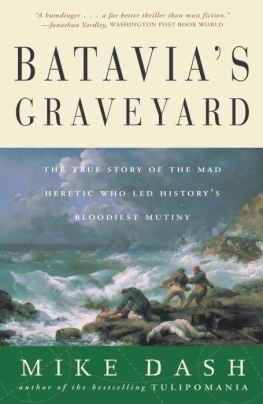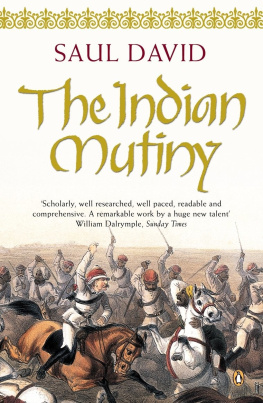Mike Dash - Batavias Graveyard: The True Story of the Mad Heretic Who Led Historys Bloodiest Mutiny
Here you can read online Mike Dash - Batavias Graveyard: The True Story of the Mad Heretic Who Led Historys Bloodiest Mutiny full text of the book (entire story) in english for free. Download pdf and epub, get meaning, cover and reviews about this ebook. year: 2002, publisher: Crown Publishers, genre: Adventure. Description of the work, (preface) as well as reviews are available. Best literature library LitArk.com created for fans of good reading and offers a wide selection of genres:
Romance novel
Science fiction
Adventure
Detective
Science
History
Home and family
Prose
Art
Politics
Computer
Non-fiction
Religion
Business
Children
Humor
Choose a favorite category and find really read worthwhile books. Enjoy immersion in the world of imagination, feel the emotions of the characters or learn something new for yourself, make an fascinating discovery.

Batavias Graveyard: The True Story of the Mad Heretic Who Led Historys Bloodiest Mutiny: summary, description and annotation
We offer to read an annotation, description, summary or preface (depends on what the author of the book "Batavias Graveyard: The True Story of the Mad Heretic Who Led Historys Bloodiest Mutiny" wrote himself). If you haven't found the necessary information about the book — write in the comments, we will try to find it.
Batavias Graveyard: The True Story of the Mad Heretic Who Led Historys Bloodiest Mutiny — read online for free the complete book (whole text) full work
Below is the text of the book, divided by pages. System saving the place of the last page read, allows you to conveniently read the book "Batavias Graveyard: The True Story of the Mad Heretic Who Led Historys Bloodiest Mutiny" online for free, without having to search again every time where you left off. Put a bookmark, and you can go to the page where you finished reading at any time.
Font size:
Interval:
Bookmark:
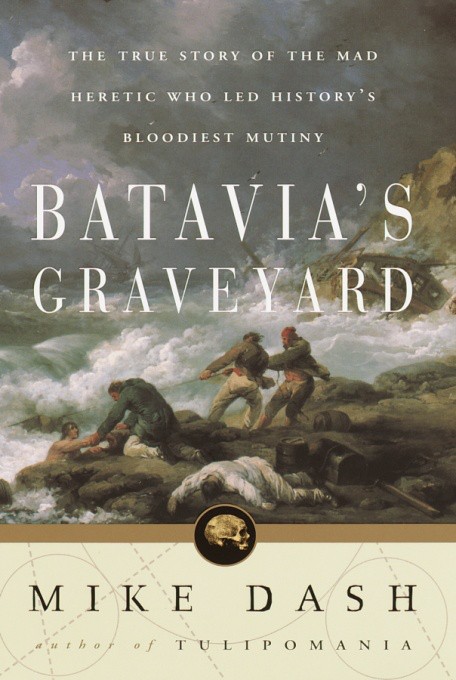

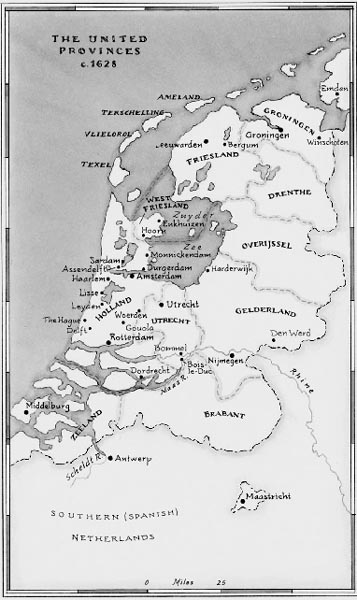
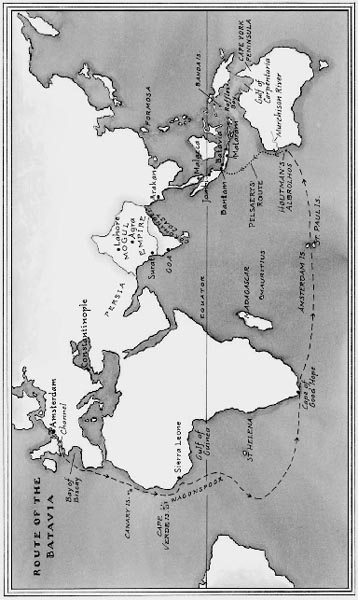
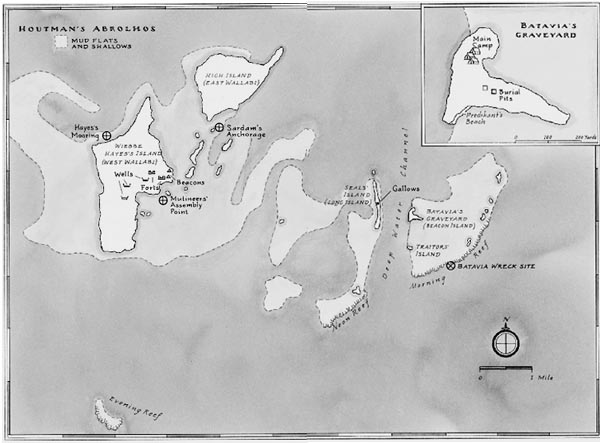
Contents
For Penny: my Creesje
I looked at him with great sorrow: such a scoundrel, cause of so many disasters and of the shedding of human blood. Besmirched in every way not only with abominable misdeeds but also with damnable heresy... and still he had the intention to go on.
FROM THE INTERROGATION OF JERONIMUS CORNELISZ
BY FRANCISCO PELSAERT
Preface
ABSOLUTELY NOTHING IN THIS BOOK IS INVENTED. It is closely based oncontemporary sources, and direct quotes, where they appear, are drawn from those samedocuments. In the few places where I have drawn my own conclusions about the thoughts andactions of the Batavias passengers and crew, I have indicated the fact in thenotes.
Jeronimus Cornelisz and his companions sailed at a time when the use of surnameswas still rare in the Dutch Republic, and when it was correspondingly common for names tobe spelled and written in several different ways within a single document. I have takenadvantage of this fact to avoid the possibility of confusion between two similarly namedpeople, where there is contemporary authority for such usage. Thus Daniel Cornelisz, amutineer, is referred to as Cornelissen throughout, to prevent him beingconfused with Jeronimus; and of the two Allert Janszes who were on the ship, one hasbecome Allert Janssen.
It is impossible to make accurate comparisons between prices in the Golden Age ofthe Dutch Republic and todays prices, butroughly estimatedone guilder in1629 bought the equivalent of $75 in 2001.
Place names are spelled as they were in the seventeenth century, thus Leydenrather than Leiden, and Sardam rather than Zaandam.
MIKE DASH, London, June 2001
Prologue
Morning Reef
The pack of all disasters has moulded together and fallen on myneck.
FRANCISCO PELSAERT
THE MOON ROSE AT DUSK ON THE EVENING OF 3 JUNE 1629, sending soft grey shaftsof light skittering across the giant swells of the eastern Indian Ocean. The beams dartedtheir way from crest to crest, racing each other for mile after mile across the emptyvastness of sea, until at last they caught and silhouetted something for an instant, agreat black mass that wallowed in a trough between the waves.
In another second, the shape surged onward, rushing up the shifting wall of waterin its path until it breasted the next swell. As it did so, it reared up momentarily andthe moon fixed it as it slapped back into the water and sent plumes of fine white sprayinto the air on either side.
In the half-light of the southern winter, the black mass stood revealed as asubstantial ship, steering north with the sting of a sharp wind at her back. She was builtin the European style, squat and square-sailed, and she looked unbalanced, beingconsiderably lower forward than she was aft. Her curved beak of a prow hung so close tothe sea that it was frequently awash with a foam of dark water, but from there her deckscurved sharply up like some massive wooden scimitar, rising so steeply that she toweredalmost 40 feet out of the water at the stern. As the ship came on, the moon was brightenough to pick out some of the larger details along the hull: her figurehead (a woodenlion springing upward), a tangled mass of rigging, the giant iron anchors lashed upsidedown along her sides. Her bows were blunt, and both the broadness of her beam and thefullness of her draught marked her as a merchant vessel.
Although the moon was bright that evening, there was too little light for theship to be identified by the flags that writhed and snapped from all three of her masts,and there was little sign of activity on deck. The gunports had all been closed, and noteven the quick glint of a lamp or two, shining through chinks in the hatches, hinted atlife within. But an enormous lantern, five feet tall, hung over the stern, and its yellowglow illuminated the richly decorated woodwork beneath just well enough for a keen eye topick out painted details that revealed the great ships name and her homeport.
She was the East Indiaman Batavia, seven months out of Amsterdam on hermaiden voyage and still some 30 days sailing from her destination, the Dutch tradingsettlements on the island of Java. Behind her, trailing in the phosphorescence of herwake, lay 13,000 miles of sea. Ahead were another 1,800 miles of uncharted ocean that had,by the end of the third decade of the seventeenth century, been crossed by only a handfulof European vessels. There was rumor and speculation aplenty, among the geographers ofEngland, the Netherlands, and Spain, about what might lie over the horizon in the immenseblank that stretched south on their globes from the known waters of the Indies, but littleinformation and no certain knowledge. The few charts of this unknown region that the Bataviacarried were fragmentary in the extreme, and all but useless as navigational aids. So shesailed on blind into the gathering night, trusting to God and the skipper as the hourglasstrickled away the minutes to midnight and the change of watch.
The ship had been brand-new when she left the Netherlands, but she was weatherednow. Her upperworks, which had been painted pale green with embel-lishments in red andgold, were chipped and worn and scoured by sea salt. Her bottom, which had once beensmooth and clean, was now festooned with so many barnacles and weeds that their dragslowed her progress north. And her hull, built though it was from oak, had been subjectedto every conceivable extreme of temperature, so that it now shuddered as the ship rolledin the swell. First the Batavias timbers had swollen in the northern winter,for she had left Amsterdam late the previous October when the northern seas were alreadycold and stormy. Then they had been shriveled by the sun as the ship sailed along thefever coasts of Africa, swung west on passing Sierra Leone, and crossed the equator headedfor Brazil. Off the coast of South America she had at last turned east, picking up acurrent that carried her to the Cape of Good Hope and then fierce easterlies that took herthrough the Roaring Forties and the Southern Ocean, where it was winter once again andperpetual gales hurried her onward, between the barren little islets of St. Paul andAmsterdam and into the unknown waters to the east.
At least it was warmer now, and the storms had abated as the Bataviaheaded north after more than seven long months at sea. But the endless discomforts of thevoyage had if anything grown worse, and outweighed the slow improvement in the weather.The fresh food was long gone, the water was alive with worms, and below deck the shipherself stank of urine, unwashed bodies, and stale breath. Worst of all, in its own way,was the plodding monotony of the endless days at sea, which ate away the spirit of thepassengers and undermined the efficiency of the crew.
At 12 the watch changed. The new watch, the midnight watch, was alwaysacknowledged to be the most difficult and dangerous of all. Working conditions were attheir worst, and the alertness of the men could not always be taken for granted. For thesereasons it was customary for the skipper himself to be on deck by night, and as the lastgrains of sand slid through the glass, a small doorway opened on one of the upper decksand he came up.
Next pageFont size:
Interval:
Bookmark:
Similar books «Batavias Graveyard: The True Story of the Mad Heretic Who Led Historys Bloodiest Mutiny»
Look at similar books to Batavias Graveyard: The True Story of the Mad Heretic Who Led Historys Bloodiest Mutiny. We have selected literature similar in name and meaning in the hope of providing readers with more options to find new, interesting, not yet read works.
Discussion, reviews of the book Batavias Graveyard: The True Story of the Mad Heretic Who Led Historys Bloodiest Mutiny and just readers' own opinions. Leave your comments, write what you think about the work, its meaning or the main characters. Specify what exactly you liked and what you didn't like, and why you think so.


